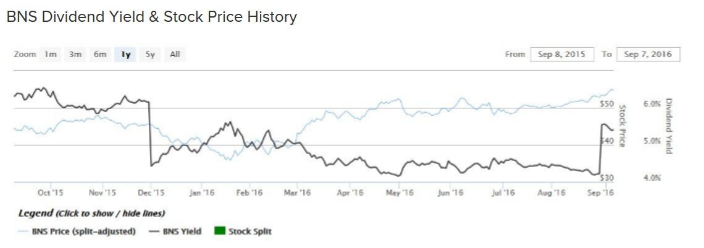Long-Term Earnings Growth Drives Dividends
Bank of Nova Scotia (BNS ) is a well-run company. It has remained steadily profitable over the past year and is growing earnings. Therefore, BNS continues to reward shareholders with compelling cash returns, including a significant dividend. The company recently declared a $0.74 per share dividend (in Canadian currency) payable on Oct. 27, 2016, to shareholders of record at the close of business on Oct. 4, 2016.
After providing third-quarter financial results, Bank of Nova Scotia declared the 2.8% dividend increase. In U.S. dollar terms, the stock has a 4.3% current dividend yield, which is very attractive since the S&P 500 Index has a 2.1% current dividend yield on average. That means Bank of Nova Scotia stock provides more than double the dividend income than the average stock in the S&P 500. And the stock has also rewarded investors with compelling share price gains over the past year. Shares of Bank of Nova Scotia have increased 22% in the past one year, not including its hefty dividend. Bank of Nova Scotia has a 4.4% dividend yield in U.S. dollar terms, and is an attractive stock pick for dividend investors.

History of Steady Growth
Bank of Nova Scotia has a long history of reliable growth, which has allowed it to consistently raise its shareholder dividend regularly. In the ten-year period through Dec. 31, 2015, Bank of Nova Scotia generated 6% compound annual earnings growth, and raised its dividend by 7.5% per year in that period. Going back further, it increased its dividend in 48 out of the past 50 years.
Last year, Bank of Nova Scotia earned $5.67 per share, which was 4.4% growth from 2014’s earnings per share. The company generated $7.2 billion of net income and $24 billion of revenue. The company has achieved steady growth for many years, thanks to its global operations and geographic diversification. Bank of Nova Scotia has a significant footprint in several emerging market regions such as Asia and Latin America, where economic growth is projected to rise at a faster pace than in developed markets.
This has helped the company this year. Even in a difficult operating environment characterized by low interest rates and heightened geopolitical risk, Bank of Nova Scotia reported a 5% increase in year-to-date earnings through the third fiscal quarter. And in this time, it has generated a strong return on equity ratio of 14.3%.
Valuation
Bank of Nova Scotia is a cheap stock, despite its high level of profitability and potential for future acceleration of earnings growth. The stock trades for just 12 times earnings per share. By comparison, the S&P 500 Index trades for approximately 20 times earnings per share. Bank of Nova Scotia is expected to grow earnings per share by 5% this year, which should allow the company to continue increasing its dividend going forward.
To be sure, the recent dividend increase is in Canadian dollars. The U.S. dollar equivalent may not change due to currency translation. But the rally in the U.S. dollar that has taken place over the past year is likely not permanent, as foreign exchange rates fluctuate and are often cyclical.
Risks
There are two significant risks for investors to worry about when it comes to Bank of Nova Scotia. The first is the health of its loan portfolio, specifically the condition of its loans issued to oil and gas companies. As the commodity sector is a large part of the Canadian economy, Bank of Nova Scotia is at risk of losses from loans made to this industry, due to the steep drop in commodity prices over the past two years. Reflecting these challenges, Bank of Nova Scotia booked $1.9 billion in provision for credit losses last year, up from $1.7 billion in 2014.
Fortunately, Bank of Nova Scotia has maintained a disciplined approach to its loan portfolio and has reduced its allocation to the commodity sector. Loans to the oil and gas industry comprised just 3.5% of Bank of Nova Scotia’s total loans as of the end of 2015. This kept losses manageable and the bank generated a 10.3% Common Equity Tier One ratio last year, which implies sufficient liquidity.
The second major risk for Bank of Nova Scotia is low interest rates. Since the financial crisis and recession of 2008, the U.S. Federal Reserve lowered interest rates to zero as part of a monetary easing policy. This policy has hurt the financial sector. Interest rates remain at historically low levels. This zero interest rate policy has helped consumers and corporations access cheap debt, but on the other hand it means banks earn less from their loans. Banks earn a spread between the money paid out on deposits and the money earned on long-term loans. This spread widens when rates rise, but it contracts when rates are low.
If the Fed decides to keep interest rates steady into 2017, it will be a continued headwind on the banks. But if interest rates go up, Bank of Nova Scotia will benefit.
The Bottom Line
Bank of Nova Scotia stock has outperformed the S&P 500 in the past one year, despite a harsh operating climate with persistently low interest rates. The stock is still attractive on a valuation basis and it offers a dividend yield double that of the S&P 500.
The company has been very successful growing earnings and dividends for a prolonged period. Bank of Nova Scotia is a well-managed company with growth potential up ahead.





